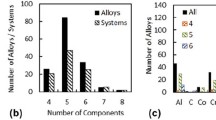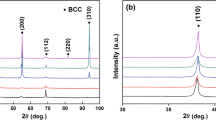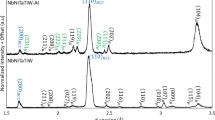Abstract
The purpose of this work is to predict elastic and thermodynamic properties of chromium-based alloys based on first-principles calculations and to demonstrate an appropriate computational approach to develop new materials for high-temperature applications in energy systems. In this study, Poisson ratio is used as a screening parameter to identify ductilizing additives to the refractory alloys. The results predict that elements such as Ti, V, Zr, Nb, Hf, and Ta show potential as ductilizers in Cr while Al, Ge, and Ga are predicted to decrease the ductility of Cr. Experimental evidence, where available, validates these predictions. The purpose of this work is to predict elastic and thermodynamic properties of chromium-based alloys based on first-principles calculations and to demonstrate an appropriate computational approach to develop new materials for high-temperature applications in energy systems. In this study, Poisson ratio is used as a screening parameter to identify ductilizing additives to the refractory alloys. The results predict that elements such as Ti, V, Zr, Nb, Hf, and Ta show potential as ductilizers in Cr while Al, Ge, and Ga are predicted to decrease the ductility of Cr. Experimental evidence, where available, validates these predictions.
Similar content being viewed by others
References
B.P. Bewlay et al., Metall. Mater. Trans. A, 34A (2003), pp. 2043–2052.
P. Jehanno et al., Metall. Mater. Trans. A, 36A (2005), pp. 515–523.
Ö.N. Doğan, Oxidation of Metals, 69 (2008), pp. 233–247.
W.D. Klopp, J. Metals, 21 (1969), pp. 23–32.
Y.F. Gu, H. Harada, and Y. Ro, JOM, 56(9) (2004), pp. 28–33.
M.J. Mehl et al., Phys. Rev. B, 41 (1990), pp. 10311–10323.
U.V. Waghmare et al., Model. Simul. Mater. Sci. Eng., 6 (1998), pp. 493–506.
W.T. Geng, Phys. Rev. B, 68 (2003), art. No. 233402.
N.I. Medvedeva, Y.N. Gornostyrev, and A.J. Freeman, Phys. Rev. B, 67 (2003), art. No. 134204.
L. Vitos, P.A. Korzhavyi, and B. Johansson, Nature Mater., 2 (2003), pp. 25–28.
M.C. Gao et al., Metall. Mater. Trans. A, 36A (2005), pp. 3269–3279.
C.B. Geller et al., Scripta Mater., 52 (2005), pp. 205–210.
S. Curtarolo, D. Morgan, and G. Ceder, CALPHAD, 29 (2005), pp. 163–211.
M.C. Gao, A.D. Rollett, and M. Widom, CALPHAD, 30 (2006), pp. 341–348.
M.C. Gao, A.D. Rollett, and M. Widom, Phys. Rev. B, 75 (2007), art. No. 174120
M.C. Gao et al., Metall. Mater. Trans. A, 38A (2007), pp. 2540–2551.
S.F. Pugh, Phil. Mag., 45 (1954), pp. 823–843.
A.H. Cottrell, Advances in Physical Metallurgy, ed. J.A. Charles and G.C. Smith (London: Institute of Metals, 1990), pp. 181–187.
J. Schroers and W.L. Johnson, Phys. Rev. Lett., 93 (2004), art. No. 255506.
J.J. Lewandowski, W.H. Wang, and A.L. Greer, Phil. Mag. Lett., 85 (2005), pp. 77–87.
T.B. Massalski et al., Binary Alloy Phase Diagrams (Materials Park, OH: ASM International, 1995).
G. Kresse and J. Hafner, Phys. Rev. B, 47 (1993), pp. 558–561.
G. Kresse and J. Furthmueller, Phys. Rev. B, 54 (1996), pp. 11169–11186.
P.E. Blöchl, Phys. Rev. B, 50 (1994), pp. 17953–17979.
J.P. Perdew, K. Burke, and M. Ernzerhof, Phys. Rev. Lett., 77 (1996), pp. 3865–3868.
A.V. Hershey, J. Appl. Mech., 21 (1954), pp. 236–240.
H. Kurishita, T. Kuwabara, and M. Hasegawa, Mat. Sci. Eng. A, 433 (2006), pp.32–38.
C.S. Wukusick, Refractory Metals and Alloys IV—Research and Development (New York: Gordon and Breach Science Publishers, 1967), pp. 231–245.
M.P. Brady et al., Scripta Mater., 52 (2005), pp. 815–819.
U. Holzwarth and H. Stamm, J. Nucl. Mater., 300 (2002), pp. 161–177.
M.P. Brady, private communications (2008).
J.R. Rice and R. Thomson, Phil. Mag., 19 (1974), pp. 73–97.
Author information
Authors and Affiliations
Corresponding author
Rights and permissions
About this article
Cite this article
Gao, M.C., Doğan, Ö.N., King, P. et al. The first-principles design of ductile refractory alloys. JOM 60, 61–65 (2008). https://doi.org/10.1007/s11837-008-0092-1
Published:
Issue Date:
DOI: https://doi.org/10.1007/s11837-008-0092-1




